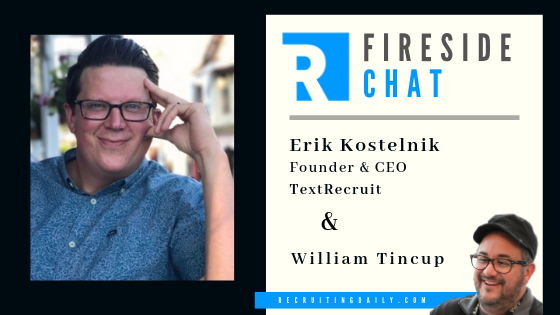
William and Erik have known one another for longer than either wants to admit. Recently we sat down to talk about the industry and get his hot takes on what’s going on. Erik is both smart and extremely approachable. If you see him at a conference, make sure you say hello. If you don’t know Erik, this is official bio – Erik Kostelnik is the co-founder and CEO of TextRecruit, a candidate and employee engagement platform that leverages text, chat, and artificial intelligence to help companies hire better people, faster. Prior to TextRecruit, Erik served as the Head of Sales at Wrike from 2014 to 2016 helping it reach #116 in 2015 Deloitte Fastest 500 and ran sales as VP at Identified through its acquisition by Workday in 2014. He acts as an advisor to startups including Eatify.com and Outreach.io, was named an Upstart 50 Inventor by the Silicon Valley Business Journal and lives in San Jose with his wife and three kids.

Q1: Work-related, what’s keeping you up at night these days?
I’m always thinking about the latest technology and how it will impact the way that employers and job seekers communicate. With these technological advancements come big responsibility – compliance. There’s a lot of sensitive information that’s exchanged throughout the recruitment process. Employers require candidates to hand this data over to begin the application process, so I consider TextRecruit and other HR software providers to be true gatekeepers of that information. We have an obligation to handle personal data with care so that job seekers don’t have to spend their time worrying about security risks. Instead, they should be empowered to focus on the task at hand – finding a job.
With GDPR having gone into effect in May of 2018 and the new California Consumer Privacy Act which slated to go into effect in January 2020, there have been some positive shifts in data protection law. Whether or not an organization is dealing with international or California-based candidates, the issue of processing and storing personal data has been brought to the forefront of the recruitment landscape, and it’s shining a light on some very real concerns. We’ve had to ask ourselves a few questions: are we doing our part in ensuring that job seekers are in control of their personal data? Do we offer an opt-in/opt-out option? Does our software support professionals in editing or deleting their information? Thankfully, the answer is yes – and we’re committed to keeping it that way as we adopt emerging technology.
Q2: How have candidates changed since you started in the profession?
Candidates’ expectations and preferences have evolved over time with technological advancements. TextRecruit was founded on the observation that in order to stay relevant, businesses need to adapt to the way consumers’ communication preferences have evolved.
A few years ago, it was evident that people were relying on their mobile devices more and more. Shortly after this technological shift happened, texting entered the recruiting scene as a quick and easy way for recruiters to connect with candidates. This resonated with job seekers – in fact, in a recent survey conducted by iCIMS, 86 percent of respondents agreed that it would be beneficial to receive text messages during the job application process.
While texting has become an integral part of the recruiting process, the advent of artificial intelligence and machine learning brought with it a whole new wave of candidate communication. Employers in the food and beverage sector are using our technology to enable visiting customers to initiate a job application with a simple text, that then connects them with an automated recruiter and takes them through a quick application process, where an interview can be put on the calendar for the very next day. Employers are also using chatbots, which leverage machine learning and artificial intelligence, to provide candidates with access to 24/7 communication while on their career site, instead of waiting for hours on the phone or for several days for an email response.
Fast communication is key throughout the entire recruitment process. With record-low unemployment rates, it’s more important now than ever before that employers are in tune with what job seekers consider to be a positive candidate experience, and that they are able to hire quickly, before they are scooped up by their competition. In this kind of job market, speed is everything.
Q3: Working for iCIMS (and TextRecruit) you’ve interacted with hundreds of TA professionals, what is one piece of advice you’d give to TA leaders?
Start texting now. If you aren’t communicating with candidates via text, you’ll be quickly categorized as a company that’s behind the eight ball, and that’s not the employer brand you want to project in today’s tight labor market. Instead, you want to position your company as an attractive and innovative organization that’s up on the latest trends and technology. You also want the application process to be easy and for job seekers to have quick access and communication channels to your recruiters or automated recruiters whenever, wherever. If you’re calling yourself an employer of choice, you need to walk the walk – and that starts with prioritizing candidate communication.
Q4: What’s the future of text recruiting and/or communications with candidates?
When I think about the future of candidate communication, I see an opportunity for tremendous growth. Employers within the United States have now used TextRecruit to message more than 8 percent of the U.S. labor force. That includes approximately 80 million messages exchanged between recruiters and job seekers to date with over eight million new messages being sent each month. While texting accounts for a generous portion of today’s candidate communication, it’s just the beginning!
With the success of text messaging in the recruiting space, we learned that candidates value quick and convenient correspondence. This year, TextRecruit took that one step further to launch Automated Recruiter Interface (Ari), as the first hybrid chatbot, enabling recruiters to automate crucial tasks such as screening, answering questions, scheduling, sharing interview reminders and driving directions, and responding to job seekers’ inquiries. Ari works with employers, and if it ever has trouble answering a question, it will pass the conversation off to a human recruiter to ensure that it’s properly handled.
Technology is only going to evolve to make things easier for job seekers and employers alike throughout the entire recruitment process. We’ll continue to keep a pulse on candidates’ needs and expectations, as well as the technology that can support that vision. Next up, I think we’ll be seeing voice-recognition infiltrate the recruitment industry.
Q5: What’s the best use of text recruiting you’ve ever witnessed? Strip away client details if need be. Explain what made the campaign so unique and effective.
I think the best use-case for text recruiting is when an organization digs deep and applies that same consumer-centric mentality to their entire recruitment process – not just to the methods that they use for candidate communication. A prime example is CDW, a company that currently employs over 8,000 people and hires 400-600 new employees each year. In an effort to keep up with their hiring demands and high volume of candidate communication, they decided to move forward with incorporating text messaging into their process.
Since having done so, CDW has seen an 87 percent response rate with a text message (compared to 5 percent with a call). Most of these responses come in within two hours or less. They are sending approximately 400 text messages per day, and proudly report an opt-out rate of just 0.5%. While these are stellar results, CDW understands that providing a strong candidate experience doesn’t stop here. Today’s candidates are looking for information wherever they can get it – they’re consulting a company’s website, social media accounts, and employee reviews to answer a lot of their questions. Perhaps the most widely sought after source is social media, with ninety-four percent of all working Americans admitting that they would visit a company’s social media page when searching for a job.
Keeping this at the forefront of their recruitment strategy, CDW maintains its employer brand across its social media channels. They actively post across popular platforms like Facebook, Twitter, and LinkedIn, with strong, branded content. By doing so, CDW is effectively leveraging these channels as another way to communicate their value and perspective with candidates. The result? The benefit of fast and convenient candidate communication coupled with a strong employer brand are undeniable.
I hope you’ve enjoyed this fireside chat with Erik. In the coming weeks & months, you’ll see more from this series.
Authors
William Tincup
William is the President & Editor-at-Large of RecruitingDaily. At the intersection of HR and technology, he’s a writer, speaker, advisor, consultant, investor, storyteller & teacher. He's been writing about HR and Recruiting related issues for longer than he cares to disclose. William serves on the Board of Advisors / Board of Directors for 20+ HR technology startups. William is a graduate of the University of Alabama at Birmingham with a BA in Art History. He also earned an MA in American Indian Studies from the University of Arizona and an MBA from Case Western Reserve University.
Recruit Smarter
Weekly news and industry insights delivered straight to your inbox.




